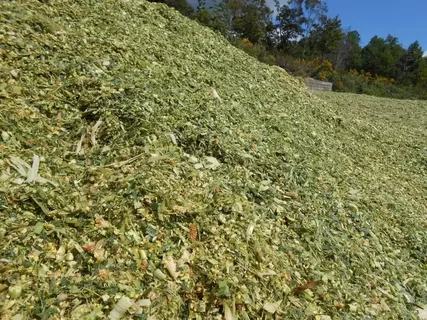Corn Silage Market gaining traction as sustainable feed solution for cattle and dairy farms

Introduction
The Corn Silage Market is gaining widespread attention as a sustainable and cost-effective feed solution for cattle and dairy farms worldwide. With increasing focus on environmentally responsible livestock nutrition, corn silage presents a reliable alternative to conventional feeding systems.
What Makes Corn Silage a Sustainable Choice?
Corn silage, made by fermenting the entire corn plant, is not just high in energy and digestibility—it’s also remarkably efficient to produce. Sustainability in animal agriculture is judged by how much output (milk or meat) is achieved with minimal environmental input (land, water, and emissions). Corn silage fits this model because:
-
It utilizes the whole plant, reducing waste
-
It supports high milk yields per unit of feed
-
It grows quickly and offers high biomass per acre
-
It stores well, limiting seasonal shortages and feed spoilage
These qualities contribute to environmental efficiency, cost-effectiveness, and long-term food security.
Rising Demand from Dairy and Cattle Farms
Globally, dairy and beef operations are under pressure to meet rising demand while controlling environmental impacts. Corn silage plays a key role in:
-
Maximizing productivity: It improves milk volume and quality in dairy cows
-
Efficient weight gain: Beef cattle fed corn silage reach market weight faster
-
Reducing methane emissions: Compared to hay or low-energy feeds, corn silage produces fewer greenhouse gases per kilogram of milk or meat
-
Lower feed costs: Silage cuts reliance on grain-based feeds, which are often more expensive
As a result, dairy cooperatives and livestock producers are increasingly adopting silage-based feeding systems.
Environmental Benefits of Corn Silage
Corn silage contributes to a more sustainable livestock industry through:
1. Land Efficiency
One acre of corn produces significantly more feed energy than the same area used for pasture or grain feed, making it ideal for areas with limited land resources.
2. Water Conservation
Corn is a relatively drought-tolerant crop, and modern irrigation systems reduce water usage even further. Silage production also uses less water than cultivating multiple feed crops separately.
3. Reduced Greenhouse Gases
Silage fermentation is an anaerobic process, which means it stores well without requiring energy-intensive preservation. Feeding high-energy corn silage reduces enteric fermentation in cows, leading to fewer methane emissions.
4. Improved Soil Health
Crop rotation involving corn helps in restoring soil nutrients. When integrated with cover crops, silage farming can also reduce soil erosion and chemical runoff.
Economic and Operational Advantages
Sustainability also means financial viability. Corn silage supports profitability in several ways:
-
Lower input costs: Silage production requires fewer inputs per ton of feed than grain production.
-
Long-term storage: It can be stored and fed year-round, stabilizing costs during feed price fluctuations.
-
Reduced waste: Properly fermented silage has minimal spoilage losses, enhancing feed utilization.
-
Consistent quality: Uniformity in feed composition supports better animal health and lower veterinary costs.
These benefits make corn silage an attractive option for farmers striving to improve sustainability while staying competitive.
Global Trends Supporting Silage Adoption
Corn silage is becoming central to feed strategies worldwide due to several reinforcing trends:
-
Precision agriculture: Farmers use tools to monitor crop growth and optimize harvest timing for better silage quality
-
Feed efficiency programs: Dairy and beef operations are prioritizing feed conversion efficiency
-
Policy incentives: Some countries offer support for silage units and mechanization in small farms
-
Organic demand: As demand for organic milk and meat rises, corn silage grown without chemical inputs finds new markets
These trends ensure a sustained and growing role for silage in agricultural supply chains.
Challenges and Sustainability Solutions
While the benefits are clear, some hurdles remain:
-
Initial setup cost: Making quality silage requires harvesters, storage bags, and inoculants
-
Farmer training: Knowledge of correct moisture levels, compaction, and sealing is essential
-
Climate sensitivity: Unpredictable weather can affect harvest timing and fermentation outcomes
Solutions include:
-
Government grants and subsidies for equipment
-
Mobile apps providing real-time harvesting and storage guidance
-
Farmer cooperatives pooling resources for silage production and training
With proper support, even small and marginal farmers can integrate silage into their operations.
The Future of Sustainable Feeding
Corn silage will likely become even more critical in future farming systems. With rising concerns about food security and environmental conservation, feeding strategies that reduce waste, improve efficiency, and lower emissions are essential.
Innovations in hybrid seed varieties, fermentation enhancers, and digital monitoring will continue to improve the sustainability profile of corn silage. Moreover, climate-resilient silage solutions—such as low-moisture techniques or solar-powered storage systems—are being developed for regions with erratic weather.
Conclusion
Corn silage is more than just an alternative feed; it is a cornerstone of sustainable livestock and dairy farming. Its efficiency, nutritional value, and environmental compatibility make it a practical solution for farmers aiming to increase productivity while minimizing ecological impact. As the world’s agricultural systems evolve, corn silage is well-positioned to support both animal performance and sustainability goals.
- Art
- Causes
- Crafts
- Dance
- Drinks
- Film
- Fitness
- Food
- Games
- Gardening
- Health
- Home
- Literature
- Music
- Networking
- Other
- Party
- Religion
- Shopping
- Sports
- Theater
- Wellness


